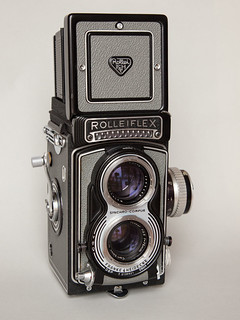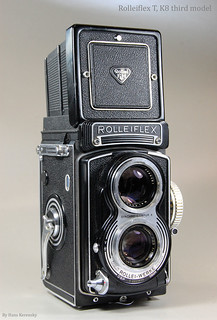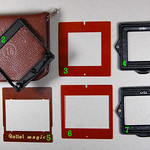Difference between revisions of "Rolleiflex T"
Hanskerensky (talk | contribs) (Moved * Parallax error correction.) |
Hanskerensky (talk | contribs) (Moved * Parallax error correction.) |
||
| Line 25: | Line 25: | ||
* Taking lens: [[Carl Zeiss]] Oberkochen Tessar 1:3.5 f=75mm. | * Taking lens: [[Carl Zeiss]] Oberkochen Tessar 1:3.5 f=75mm. | ||
* Viewing lens: Heidosmat 1:2.8 f=75mm. | * Viewing lens: Heidosmat 1:2.8 f=75mm. | ||
| + | * Filter Bayonet : Both lenses, size 1. | ||
* [[Parallax]] error correction. | * [[Parallax]] error correction. | ||
| − | |||
* Shutter: [[Synchro-Compur]] MXV CR00 leafshutter. Speeds 1 to 1/500 sec. and B. Selftimer. | * Shutter: [[Synchro-Compur]] MXV CR00 leafshutter. Speeds 1 to 1/500 sec. and B. Selftimer. | ||
* Flash synchronisation : Sync socket on front panel, M and X synchronisation. | * Flash synchronisation : Sync socket on front panel, M and X synchronisation. | ||
Revision as of 14:36, 5 December 2014
The Rolleiflex T is a medium format TLR camera manufactured by Franke & Heidecke and later by Rollei.
Contents
General
Rollei did perceive that there was a big price gap between the Rolleicord and the Rolleiflex at that time (1957).
To fill that gap they decided to design and produce the Rolleiflex T.
To cut costs the automatic film start sense mechanism was abandoned and instead the way of the Rolleicord used, a start marker alongside the film gate. The front mechanisms was simplified for the same reason.
There were 3 models manufactured :
- Model 1 from 1958 to 1961
- Model 2 from 1961 to 1966
- Model 3 from 1966 to 1973, this model can further be divided in cameras with Tessar lenses and those with Xenar lenses.
Model 1 Specifications

|
| Rolleiflex T, Model 1 image by Lutz Schramm (Image rights) |
- Format : 12 exposures of 6 x 6 cm on 120 type rollfilm.
By using a special mask set the camera can be adapted to shoot 16 images 4x4 or 4x5.5cm on a roll. The mask put into the filmgate does automaticly change the frame counter from 12 to 16 exposures.
Furthermore an optional Plate adapter for sheet film. - Taking lens: Carl Zeiss Oberkochen Tessar 1:3.5 f=75mm.
- Viewing lens: Heidosmat 1:2.8 f=75mm.
- Filter Bayonet : Both lenses, size 1.
- Parallax error correction.
- Shutter: Synchro-Compur MXV CR00 leafshutter. Speeds 1 to 1/500 sec. and B. Selftimer.
- Flash synchronisation : Sync socket on front panel, M and X synchronisation.
- Lighmeter system : Optional, coupled, Selenium photo element, 2 ranges.
- Color Leatherette : Grey
- Dimensions WxDxH: 112 x 97 x 148 mm
- Weight: 1020 grams
Model 1 Special versions
- A small quantity was produced which had a special mask set to shoot 24 images 24x36mm on a roll. The mask put into the filmgate does automaticly change the frame counter from 12 to 24 exposures.
Model 2 Specifications

|
| Rolleiflex T, Model 2 image by F4ronnie (Image rights) |
Only sections which differ from Model 1 shown.
- Format : 12 exposures of 6 x 6 cm on 120 type rollfilm.
By using a special mask set the camera can be adapted to shoot 16 images 4x4 or 4x5.5cm on a roll. The mask put into the filmgate does automaticly change the frame counter from 12 to 16 exposures.
Furthermore an optional Plate adapter for sheet film.
Furthermore, by using an optional Rolleikin 2 adapter 35mm film cartridges can be used. - Color Leatherette : Black
Model 3 Specifications

|
| Rolleiflex T, Model 3 image by Hans Kerensky (Image rights) |
Only sections which differ from Model 2 shown.
- Taking lens: Carl Zeiss Oberkochen Tessar or Schneider Kreuznach Xenar 1:3.5 f=75mm.
- Shutter: Synchro-Compur XV CR00 leafshutter. Speeds 1 to 1/500 sec. and B. Selftimer.
- Flash synchronisation : Sync socket on front panel, X synchronisation.

|
| 16 images mask set image by Hans Kerensky (Image rights) |
Bibliography
- Claus Prochnow, Rollei Report 2, third edition, Braunschweich, Lindemanns Verlag, 2008, ISBN 3-89506-220-0.